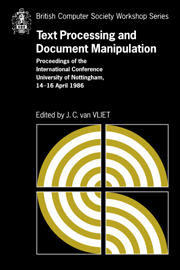 Text Processing and Document Manipulation
Text Processing and Document Manipulation Book contents
- Frontmatter
- Contents
- Preface
- The Design of Lucida®: an Integrated Family of Types for Electronic Literacy
- Tabular Typography
- A Simple Mechanism for Authorship of Dynamic Documents
- VORTEXT: VictORias TEXT reading and authoring system
- An Approach to the Design of a Page Description Language
- Intelligent Matching and Retrieval for Electronic Document Manipulation
- A Disciplined Text Environment
- Semantic Guided Editing: A Case Study On Genetic Manipulations
- Trends and Standards in Document Representation
- Textmaster – document filing and retrieval using ODA
- Combining Interactive Document Editing with Batch Document Formatting
- Formatting Structure Documents: Batch versus Interactive?
- Advanced Catalogue Production at Unipart
- Legibility of Digital Type-fonts and Comprehension in Reading
- An Overview of the W Document Preparation System
- Grif: An Interactive System for Structured Document Manipulation
- Procedural Page Description Languages
- A Strategy for Compressed Storage and Retrieval of Documents
- CONCEPT BROWSER: a System for Interactive Creation of Dynamic Documentation
- An Integrated, but not Exact-Representation, Editor/Formatter
- An Annotated Bibliography on Document Processing
- Systems used
Intelligent Matching and Retrieval for Electronic Document Manipulation
Published online by Cambridge University Press: 05 May 2010
- Frontmatter
- Contents
- Preface
- The Design of Lucida®: an Integrated Family of Types for Electronic Literacy
- Tabular Typography
- A Simple Mechanism for Authorship of Dynamic Documents
- VORTEXT: VictORias TEXT reading and authoring system
- An Approach to the Design of a Page Description Language
- Intelligent Matching and Retrieval for Electronic Document Manipulation
- A Disciplined Text Environment
- Semantic Guided Editing: A Case Study On Genetic Manipulations
- Trends and Standards in Document Representation
- Textmaster – document filing and retrieval using ODA
- Combining Interactive Document Editing with Batch Document Formatting
- Formatting Structure Documents: Batch versus Interactive?
- Advanced Catalogue Production at Unipart
- Legibility of Digital Type-fonts and Comprehension in Reading
- An Overview of the W Document Preparation System
- Grif: An Interactive System for Structured Document Manipulation
- Procedural Page Description Languages
- A Strategy for Compressed Storage and Retrieval of Documents
- CONCEPT BROWSER: a System for Interactive Creation of Dynamic Documentation
- An Integrated, but not Exact-Representation, Editor/Formatter
- An Annotated Bibliography on Document Processing
- Systems used
Summary
ABSTRACT
The paper presents a new system for automatic matching of bibliographic data corresponding to items of full textual electronic documents. The problem can otherwise be expressed as the identification of similar or duplicate items existing in different bibliographic databases. A primary objective is the design of an interactive system where matches and near misses are displayed on the user's terminal so that he can confirm or reject the identification before the associated full electronic versions are located and processed further.
Introduction
There is no doubt that ‘electronic publishing’ and other computer based tools for the production and dissemination of printed material open up new horizons for efficient communication. The problems currently faced by the designers of such systems are enormous. One problem area is the identification of duplicate material especially when there is more than one source generating similar documents. Abstracting is a good example here. Another problem area is the linkage between full text and bibliographic databases.
As part of its attempt to establish collaboration between different countries, the European Economic Community initiated the DOCDEL programme of research and a series of studies such as DOCOLSYS which investigate the present situation in Europe regarding document identification, location and ordering with particular reference to electronic ordering and delivery of documents.
The majority of DOCDEL systems likely to be developed fall under one of the following areas:
(a) Delivery from computer-based systems
(b) Delivery from non-computer based systems
(c) Electronic publishing
(d) On-demand publishing
- Type
- Chapter
- Information
- Text Processing and Document ManipulationProceedings of the International Conference, University of Nottingham, 14-16 April 1986, pp. 65 - 77Publisher: Cambridge University PressPrint publication year: 1986
- 3
- Cited by


